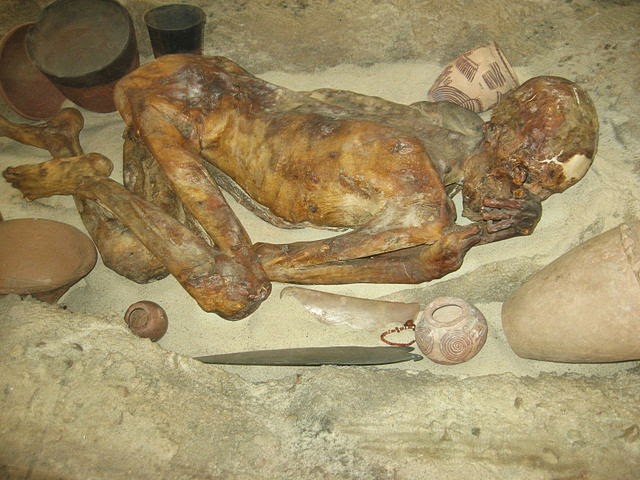The incredible preservation techniques of mummification leave bodies eerily intact — so much so that visiting these famous mummies can feel like visiting the living dead. Mummies often have preserved skeletons, skin, and even recognizable faces. We often associate mummification with ancient Egypt, but people who lived as recently as the 1900s have been mummified. Here are 12 of the world's most famous mummies.
First known Egyptian mummy (3400 BC)
This mummy, nicknamed Ginger, is one of the first known mummified bodies of ancient Egypt. Ginger’s fingernails, toe and hair are perfectly preserved. It’s unclear if Ginger was intentionally mummified, but he was buried with belongings so it’s likely it was on purpose. Ginger is on display in the British Museum.
Hatshepsut was one of the most powerful female pharaohs. Her body was discovered in 1902 in Egypt’s Valley of the Kings. Earlier, a tomb marked as the pharaoh’s had been discovered empty but finally, two tombs—one containing Hatshepsut’s body and one containing her wet nurse’s—were discovered. The pharaoh was identified by a tooth in her coffin that fit her jaw perfectly.
Source
Lady Dai (Xin Zhui, 178-145 B.C.)
Lady Dai is said to be the most perfectly preserved corpse of all time. She was discovered in 1971 when Chinese workers digging an air raid shelter found a massive Han Dynasty tomb. The body was so well preserved it was able to be autopsied just as if it were a recently deceased person’s body. Researchers believe layers of silk and hemp contributed to the incredible preservation, but there is also an unidentified red liquid in her coffin that could have something to do with it. Lady Dai is on display in the Hunan Provincial Museum.
Source
Rosalia Lombardo (1918-1920)
Lombardo was an Italian baby who died of pneumonia at a very young age. The girl’s parents were so devastated that they had her body preserved. Lombardo was one of the last bodies added to the catacombs in Sicily. She looks as if she’s just sleeping and has been nicknamed “Sleeping Beauty.” The identity of Lombardo’s balm ingredients were only recently revealed as formalin, zinc salts, alcohol, salicylic acid, and glycerin.
Source
Saint Bernadette (1844-1879)
Bernadette was a miller’s daughter in France who allegedly saw the ghost of the Virgin Mary. The Catholic Church believed her, and after her death she was canonized as a saint. Bernadette wasn’t technically mummified but her body remains completely intact and on display in the Chapel of Saint Bernadette in Nevers, France.
Source
Elmer McCurdy (1880-1911)
McCurdy was mummified for tourism purposes. An Oklahoma outlaw, nobody claimed his body after he was finally caught and killed, so the funeral home undertaker preserved the body and marketed it as “The Bandit Who Wouldn’t Give Up.” Eventually someone claiming to be a family member collected the body and started showing it in a circus. Since then, McCurdy’s body has been in museums, carnivals and more.
Ötzi the Iceman (3300 BC)
This mummy was discovered in the Ötztal Alps on the border of Italy and Austria in 1991. This is Europe’s oldest naturally preserved mummy, mummified by natural elements rather than a balm. Researchers believe he died from a blow to the head. He is on display in the South Tyrol Museum of Archaeology in Bolzano in Northern Italy.
Vesuvius volcanic corpses (79 A.D.)
The great eruption of Vesuvius left many bodies naturally mummified when ashes solidified over the bodies before they could decay. What’s left is creepily accurate molds of the victims. There’s an entire city of people-shaped plaster casts.
Vladimir Lenin (1870-1924)
Lenin was a leading Russian political figure in the 20th century and one of the architects of the U.S.S.R. Lenin survived an assassination attempt and three strokes before dying. His body was embalmed in preservatives and put on display at the Lenin Mausoleum in Moscow.
Juanita (Sometime in the 1500s)
This young girl’s body was discovered in 1995 on the summit of Mount Ampato, Peru. Part of an Inca tribe, the girl was sacrificed 500 years ago. Incans believed that the gods would grant them water and milder weather if they sacrificed humans. Juanita’s body has been covered in ice until a volcanic eruption melted her encasing. Juanita’s skin, organs and even clothes have been preserved and she is on display at the Museo Santuarios de Altura in Arequipa, Peru.
Bog Body (4th century B.C.)
This naturally preserved corpse was discovered in 1950 in a bog in Denmark. The elements of the bog preserved the body so well that when he was discovered, some thought he was a recent murder victim. The man died by hanging, and had visible rope marks on his head and neck. The Bog Body can be seen at the Silkeborg Museum in Denmark.
King Tutankhamun (1341 B.C.-1323 B.C.)
King Tutankhamun was 9 years old when he became a pharaoh but he reigned only 10 years. The king’s body was discovered in 1922, almost totally intact and in one of the most complete tombs ever found, with full bandaging, wrapping, a death mask and possessions.














No comments:
Post a Comment